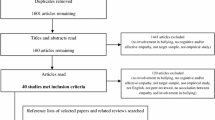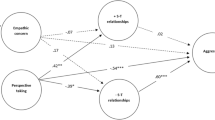Abstract
Background
Interventions aimed at reducing bullying behavior commonly target the development of empathy. Yet, few longitudinal studies have investigated how empathy levels vary with bullying and victimization over time, especially during the transition to middle school.
Objective
To that end, the purpose of the present study was to: (1) examine the naturally-occurring changes in cognitive empathy during the transition from elementary to middle school, and (2) explore the effect of bullying and victimization involvement on changes in cognitive empathy over time, and specifically during this school transition.
Methods
Latent growth curve modeling was used to examine growth trajectories in empathy over time and the effects of bullying involvement on this growth among a sample of 431 students (52 % female, 52 % Latino, 10.18 years old at baseline), using data collected during the spring semester of the 4th grade, the fall and spring semesters of 5th grade, and the spring semester of 6th grade.
Results
Cognitive empathy decreased over time, and a linear trajectory was the best fitting shape for these data. Bullying and victimization were both associated with lower levels of cognitive empathy throughout the study. However, the effect of victimization was small and it became non-significant when both were added to the model. Several notable participant-related differences were found.
Conclusions
These findings point to the potential to improve cognitive empathy skills and reduce involvement in bullying via preventive interventions prior to the transition from elementary to middle school to assist youth in making a more successful transition.

Similar content being viewed by others
Notes
The measure of cognitive empathy was not collected at the first measurement wave during the spring of fourth grade.
The ordinal alpha coefficient is a version of the Cronbach’s alpha reliability index that is based on a polychoric correlation matrix as opposed to the standard Pearson correlation matrix, which is more appropriate for ordinal items.
References
Barker, E. D., Arseneault, L., Brendgen, M., Fontaine, N., & Maughan, B. (2008). Joint development of bullying and victimization in adolescence: Relations to delinquency and self-harm. Journal of the American Academy of Child and Adolescent Psychiatry, 47, 1030–1038. doi:10.1097/CHI.0b013e31817eec98.
Bates, D., Maechler, M., Bolker, B., & Walker, S. (2015). lme4: Linear mixed-effects models using Eigen and S4. R package version 1.1-97, https://CRAN.R-project.org/package=lme4.
Bauman, S. (2008). The association between gender, age, acculturation, depression and overt and relational victimization among Mexican American elementary students. The Journal of Early Adolescence, 28, 528272–4316554. doi:10.1177/0272431608317609.
Benedict, F. T., Vivier, P. M., & Gjelsvik, A. (2014). Mental health and bullying in the United States among children aged 6 to 17 years. Journal of Interpersonal Violence, 30, 782–795. doi:10.1177/0886260514536279.
Black, A. C., Harel, O., & Matthews, G. (2012). Techniques for analyzing intensive longitudinal data with missing values. In M. R. Mehl & T. S. Conner (Eds.), Handbook of research methods for studying daily life (pp. 339–356). New York, NY: The Guilford Press.
Brown, J. A., Jimerson, S. R., Dowdy, E., Gonzalez, V., & Stewart, K. (2012). Assessing the effects of school-wide Second Step implementation in a predominately English language learner, low SES, Latino sample. Psychology in the Schools, 49, 864–875.
Burchinal, M. R., Peisner-Feinberg, E., Bryant, D. M., & Clifford, R. (2000). Children’s social and cognitive development and child-care quality: Testing for differential associations related to poverty, gender, or ethnicity. Applied Developmental Science, 3, 149–165. doi:10.1207/S1532480XADS0403_4.
Cooke, M. B., Ford, J., Levine, J., Bourke, C., Newell, L., & Lapidus, G. (2007). The effect of city-wide implementation of “Second Step” on elementary school students’ prosocial and aggressive behaviors. The Journal of Primary Prevention, 28, 93–115.
Davis, M. H. (1980). A multidimensional approach to individual differences in empathy. JSAS Catalog of Selected Documents in Psychology, 10, 85. Retrieved from http://www.uv.es/~friasnav/Davis_1980.pdf.
Davis, M. H. (1983). Measuring individual differences in empathy: Evidence for a multidimensional approach. Journal of Personality and Social Psychology, 44, 113–126. doi:10.1037/0022-3514.44.1.113.
de Guzman, M. R. T., & Carlo, G. (2004). Family, peer, and acculturative correlates of prosocial development among Latinos. Great Plains Research: A Journal of Natural and Social Sciences. http://digitalcommons.unl.edu/greatplainsresearch/718.
Efron, B., & Tibshirani, R. J. (1993). An introduction to the bootstrap. New York, NY: Chapman & Hall.
Espelage, D. L., Mebane, S. E., & Adams, M. R. (2004). Empathy, caring, and bullying: Toward an understanding of complex associations. In D. L. Espelage & S. M. Swearer (Eds.), Bullying in American schools: A social-ecological perspective in prevention and intervention (pp. 37–62). Mahwah, NJ: Lawrence Erlbaum Associates.
Espelage, D. L., & Swearer, S. M. (2003). Research on school bullying and victimization: What have we learned and where do we go from here? School Psychology Review, 32, 365–383.
Farrant, B. M., Devine, T. A. J., Mayberry, M. T., & Fletcher, J. (2012). Empathy, perspective taking and prosocial behaviour: The Importance of parenting practices. Infant and Child Development, 21, 175–188.
Forero, R., McLellan, L., Rissel, C., & Bauman, A. (1999). Bullying behaviour and psychosocial health among school students in New South Wales, Australia: Cross sectional survey. British Medical Journal, 319, 344–348. doi:10.1136/bmj.319.7206.344.
Gadermann, A. M., Guhn, M., & Zumbo, B. D. (2012). Estimating ordinal reliability for Likert-type and ordinal item response data: A conceptual, empirical, and practical guide. Practical Assessment, Research & Evaluation, 17(3), 1–13.
Galinsky, A. D., Ku, G., & Wang, C. S. (2005). Perspective-taking and self-other overlap: Fostering social bonds and facilitating social coordination. Group Processes & Intergroup Relations, 8(2), 109–124. doi:10.1177/1368430205051060.
Grühn, D., Rebucal, K., Diehl, M., Lumley, M., & Labouvie-Vief, G. (2008). Empathy across the adult lifespan: Longitudinal and experience-sampling findings. Emotion, 8, 753–765. doi:10.1037/a0014123.
Hawley, P. H. (2003). Prosocial and coercive configurations of resource control in early adolescence: A case for the well-adapted Machiavellian. Merrill-Palmer Quarterly (1982), 49, 279–309. doi:10.1353/mpq.2003.0013.
Hedges, L. V., & Olkin, I. (1985). Statistical methods for meta-analysis. San Diego, CA: Academic Press.
Jenson, J. M., Brisson, D., Bender, K. A., & Williford, A. P. (2013). Effects of a bullying prevention program on youths’ patterns of aggression and victimization during the transition to middle school. Social Work Research, 37, 361–372.
Jenson, J. M., & Dieterich, W. A. (2007). Effects of a skills-based prevention program on bullying and bully victimization among elementary school children. Prevention Science, 8, 285–296. doi:10.1007/s11121-007-0076-3.
Jenson, J. M., Dieterich, W. A., Brisson, D., Bender, K. A., & Powell, A. (2010). Preventing childhood bullying: Findings and lessons from the Denver public schools trial. Research on Social Work Practice, 20, 509–517. doi:10.1177/1049731509359186.
Jolliffe, D., & Farrington, D. P. (2004). Empathy and offending: A systematic review and meta- analysis. Aggression and Violent Behavior, 9(5), 441–476. doi:10.1016/j.avb.2003.03.001.
Jolliffe, D., & Farrington, D. P. (2006). Examining the relationship between low empathy and bullying. Aggressive Behavior, 32, 540–550. doi:10.1002/ab.20154.
Kaltiala-Heino, R., Rimpelä, M., Rantanen, P., & Rimpelä, A. (2000). Bullying at school—An indicator of adolescents at risk for mental disorders. Journal of Aadolescence, 23(6), 661–674. doi:10.1006/jado.2000.0351.
Kann, L., Kinchen, S., Shanklin, S. L., Flint, K. H., Kawkins, J., Harris, W. A., & Zaza, S. (2014). Youth risk behavior surveillance—United States, 2013. MMWR Surveillance Summary, 63(Suppl 4), 1–168.
Kaukiainen, Aa, Bjorkqvist, K., Lagerspetz, K., Osterman, K., Salmivalli, C., Rothberg, S., & Ahlbom, A. (1999). The relationships between social intelligence, empathy, and three types of aggression. Aggressive Behavior, 25, 810–889. doi:10.1002/(SICI)1098-2337(1999)25:2%3C81::AID-AB1%3E3.0.CO;2-M.
Klomek, A. B., Marrocco, F., Kleinman, M., Schonfeld, I. S., & Gould, M. S. (2007). Bullying, depression, and suicidality in adolescents. Journal of the American Academy of Child and Adolescent Psychiatry, 46, 40–49. doi:10.1097/01.chi.0000242237.84925.18.
Konrath, S. H., O’Brien, E. H., & Hsing, C. (2011). Changes in dispositional empathy in American college students over time: A meta-analysis. Personality and Social Psychology Review, 15, 180–197. doi:10.1177/1088868310377395.
Kumpulainen, K., Räsänen, E., Henttonen, I., Almqvist, F., Kresanov, K., Linna, S. L., et al. (1998). Bullying and psychiatric symptoms among elementary school-age children. Child Abuse and Neglect, 22(7), 705–717. doi:10.1016/S0145-2134(98)00049-0.
Lee, V., & Hoaken, P. N. S. (2007). Cognition, emotion, and neurobiological development: Mediating the relation between maltreatment and aggression. Child Maltreatment, 12, 281–298. doi:10.1177/1077559507303778.
Michalska, K. J., Kinzler, K. D., & Decety, J. (2013). Age-related sex differences in explicit measures of empathy do not predict brain responses across childhood and adolescence. Developmental Cognitive Neuroscience, 3, 22–32. doi:10.1016/j.dcn.2012.08.001.
Moerbeek, M. (2004). The consequence of ignoring a level of nesting in multilevel analysis. Multivariate Behavioral Research, 39, 129–149. doi:10.1207/s15327906mbr3901_5.
Nansel, T. R., Overpeck, M., Pilla, R. S., Ruan, W. J., Simons-Morton, B., & Scheidt, P. (2001). Bullying behaviors among US youth, prevalence and association with psychosoial adjustment. Journal of the American Medical Association, 285, 2094–2100. doi:10.1001/jama.285.16.2094.
Nylund, K., Bellmore, A., Nishina, A., & Graham, S. (2007). Subtypes, severity, and structural stability of peer victimization: What does latent class analysis say? Child Development, 78(6), 1706–1722. doi:10.1111/j.1467-8624.2007.01097.x.
O’Brien, E., Konrath, S. H., Grühn, D., & Hagen, L. (2013). Empathic concern and perspective taking: Linear and quadratic effects of age across the adult life span. Journal of Gerontology, 68, 168–175. doi:10.1093/geronb/gbs055.
Olweus, D. (1993). Bullying at school. Cambridge, MA: Blackwell.
Olweus, D. (1996). The Revised Olweus bully/victim Questionnaire. Bergen: Mimeo. Research Center for Health Promotion (HEMIL Center), University of Bergen.
Pellegrini, A. D., & Long, J. D. (2002). A longitudinal study of bullying, dominance, and victimization during the transition from primary school through secondary school. British Journal of Developmental Psychology, 20(2), 259–280. doi:10.1348/026151002166442.
Salmivalli, C. (2002). Is there an age decline in victimization by peers at school? Educational Research, 44(3), 269–277. doi:10.1080/00131880210135331.
Segal, E. A., Gerdes, K. E., Mullins, J., Wagaman, M. A., & Androff, D. (2011). Social empathy attitudes: Do Latino students have more? Journal of Human Behavior in the Social Environment, 21, 438–454. doi:10.1080/10911359.2011.566445.
Singer, J. D., & Willett, J. (2003). Applied longitudinal data analysis. New York, NY: Oxford University Press.
Smokowski, P. R., & Kopasz, K. H. (2005). Bullying in school: An overview of types, effects, family characteristics, and intervention strategies. Children & Schools, 27(2), 101–110. doi:10.1093/cs/27.2.101.
Sourander, A., Jensen, P., Rønning, J. A., Niemela, S., Helenius, H., Kumpulainen, K., et al. (2007). What is the early adult outcome of boys who bully or are bullied in childhood? The Finnish “from a boy to a man” study. Pediatrics, 120, 397–404. doi:10.1542/peds.2006-2704.
Srabstein, J. C., & Leventhal, B. L. (2010). Prevention of bullying-related morbidity and mortality: A call for public health policies. Bulletin of the World Health Organization, 88, 403. doi:10.2471/BLT.10.077123.
Sun, S., & Pan, W. (2014). A methodological review of statistical methods for handling multilevel non-nested longitudinal data in educational research. International Journal of Research & Method in Education, 37, 285–308. doi:10.1080/1743727X.2014.885012.
Sutton, J., Smith, P. K., & Swettenham, J. (1999). Social cognition and bullying: Social inadequacy or skilled manipulation? British Journal of Developmental Psychology, 17(3), 435–450. doi:10.1348/026151099165384.
Vaillancourt, T., Hymel, S., & McDougall, P. (2003). Bullying is power. Journal of Applied School Psychology, 19, 157–176. doi:10.1300/J008v19n02_10.
Van der Graaff, J., Branje, S., De Wied, M., Hawk, S., Van Lier, P., & Meeus, W. (2014). Perspective taking and empathic concern in adolescence: Gender differences in developmental changes. Developmental Psychology, 50, 881–888. doi:10.1037/a0034325.
van Noorden, T. H., Haselager, G. J., Cillessen, A. H., & Bukowski, W. M. (2014). Empathy and involvement in bullying in children and adolescents: A systematic review. Journal of Youth and Adolescence, 44, 637–657. doi:10.1007/s10964-014-0135-6.
Williford, A., Boulton, A. J., & Jenson, J. M. (2014). Transitions between subclasses of bullying and victimization when entering middle school. Aggressive Behavior, 40, 24–41.
Williford, A. P., Brisson, D., Bender, K., Jenson, J., & Forrest-Bank, S. (2011). Patterns of aggressive behavior and peer victimization from childhood to early adolescence: A latent class analysis. Journal of Youth and Adolescence, 40, 644–655.
Zahn-Waxler, C., Radke-Yarrow, M., Wagner, E., & Chapman, M. (1992). Development of concern for others. Developmental Psychology, 8, 126–136. doi:10.1037/0012-1649.28.1.126.
Author information
Authors and Affiliations
Corresponding author
Rights and permissions
About this article
Cite this article
Williford, A., Boulton, A.J., Forrest-Bank, S.S. et al. The Effect of Bullying and Victimization on Cognitive Empathy Development During the Transition to Middle School. Child Youth Care Forum 45, 525–541 (2016). https://doi.org/10.1007/s10566-015-9343-9
Published:
Issue Date:
DOI: https://doi.org/10.1007/s10566-015-9343-9




